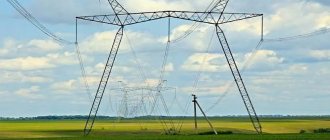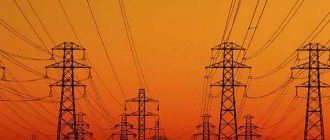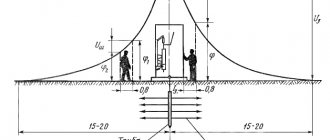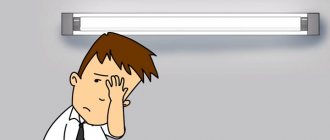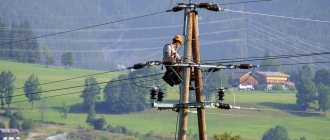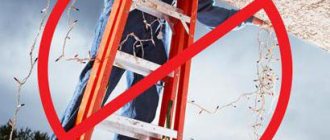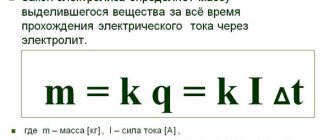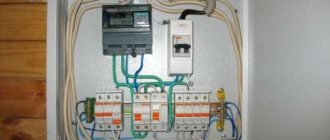Types of power lines by voltage
All electrical installations and power lines have an electromagnetic impact on the environment. The main impact parameter is the electric field strength, which shows the level of force around the wires in the power line area. Due to electromagnetic radiation, lines of force arise in the space around power lines, which, when crossing any conducting medium, can induce an EMF in it. As a result, an unusual potential appears on any object, and in the presence of a closed circuit, electric current will flow.
However, the electromagnetic field strength is not uniform in space - the intensity decreases as one moves away from the power line. In addition, the gradation of harmful effects largely depends on the rating of the transmission line.
Therefore, all power lines are divided into the following categories:
- Low voltage – supply voltage in which is up to 1 kV;
- Medium level – for lines from 1 to 35 kV;
- High voltage – ratings for 110, 154, 220 kV;
- Ultra-high – for ratings from 330 to 500 kV;
- Ultra-high – power lines with voltages of 750 and 1150 kV.
It should be noted that the effect of electromagnetic waves depends not only on the voltage level, but also on the strength of the electric current flowing through the wires. Therefore, the generally accepted standard establishes the optimal distance to live parts, which will be safe [ ].
What is a security zone and where is it installed?
A power transmission line security zone is a conditional plane laid at a certain distance from power lines, long-term crossing of which can negatively affect human health.
Features of determining the security zone of power lines according to GOST 12.1.051-90:
- The concept of a security zone refers to the space from the power line to the ground.
- The area with increased danger to the human body is enclosed by two conventional planes running vertically, to the left and right of the power lines.
Important! The conditional planes do not pass from the cables themselves, but at a distance from them specified by GOST 12.1.051-90.
- If the power transmission line is laid over a lake, river, or other type of reservoir, then imaginary planes for navigable reservoirs are determined at a distance of 100 m from the line cables, and for non-navigable reservoirs - the same as for the space above the ground.
- The distance from cables for underground power lines is at least 1 m.
- Distance from underwater power lines – 100 m.
The concepts of a security zone and a zone where there is a high probability of receiving an electric shock should not be confused. This possibility is eliminated or minimized by strictly following the rules for designing power lines, which must be strictly adhered to when constructing power lines.
Danger zone around an electrical line
Safe distance from power lines to a residential building
Since it is not practical to reduce the transmitted voltage, a so-called sanitary zone is established around the lines, establishing a minimum distance from the area where the high-voltage line is located.
Thus, according to clause 4.1 of SanPiN 2971-84, the following parameters can be distinguished:
- For 330 kV lines - the distance must be at least 20 m to the nearest buildings;
- For power lines with a nominal value of 500 kV, it is necessary to maintain a distance of up to 30 m;
- For overhead lines with a voltage of 750 kV - at least 40 m;
- A distance of more than 55 m is allowed from the supports of 1150 kV overhead lines.
Figure 1: safe distance from power lines
The remaining electrical installations are relatively safe, since the design distance established by building regulations and the size of the security zone should be quite sufficient. Despite these standards, in some cities dangerous radiation also covers other high-voltage ratings; for example, in Moscow it is prohibited for buildings, gardens and garden plots to be closer than 20 m to a 110 kV overhead line.
However, scientific research abroad leads scientists to the opinion that the above values are insufficient for human safety, therefore, in a number of countries they are guided by the power of power lines, which takes into account not only the electrical, but also the magnetic component. In European countries, an expanded danger zone is applied to the distances to power transmission line wires, 4 to 10 times larger than in the post-Soviet space. This difference occurs due to the differentiation of the intensity of the impact of magnetic and electrical components on the human body.
What actions are prohibited in the power transmission line security zone?
The high voltage under which power lines are located is a direct threat to the life and health of both maintenance personnel and random people who ignore safety rules. To minimize accidents, as well as disruptions to the operation of power lines, GOST 12.1.051-90 provides a list of actions that are prohibited from being carried out in the security zone.
In the security zone of power lines of any voltage it is prohibited:
- Construction, major repairs, demolition of buildings or structures.
- Install storage facilities for fuels and lubricants due to the possibility of unintentional ignition or fire. It is also prohibited to drain spent fuel and lubricants from nearby storage facilities into the security zone of the power line.
- Place landfills or places with large accumulations of both construction and household or industrial waste.
- Build a gas station.
- Carry out work using explosive or flammable substances. And lighting a fire is also prohibited.
- Throwing conductors over both high and low voltage wires in an attempt to steal electricity is strictly prohibited. This can lead to an accident, and in the case of high voltage power lines, death.
GOST 12.1.051-90 prohibits repair work on overhead power lines during thunderstorms or rain. If the power line has an important status and its inaction can disrupt the work of serious industrial or government enterprises, then repair work on it is allowed only when the voltage is removed. When carrying out work on overhead lines without contact with conductors, the distance from a person to the nearest cable must be at least two meters.
Working under voltage, with all technical means of protection, is allowed only in two cases: when the water jet is raised no more than 3 meters from the ground or when the water jet does not enter the security zone of the power line.
In the security zone of power lines, no work is allowed without the permission of the organizations operating them. The list also includes items such as digging up soil or laying road lines.
Harm to human health
It should be noted that all electrical devices can have harmful magnetic and electrical effects on the human body, which can lead to both deterioration of health and exacerbation of chronic diseases. Some of the recent studies by Kosov A.A. and Barabanov A.A. , the role of electromagnetic fields and radiation in the human security system confirmed the direct dependence of most biochemical reactions on the level of externally induced voltage. In turn, powerful power lines have a much greater impact, so a standard for approaching the source has been established.
Figure 2: Electric field strength differences with distance
So, depending on the location, it is allowed:
- In populated areas, the voltage is no more than 5 kV/m;
- At intersections of highways and pedestrian roads up to 10 kV/m;
- Outside populated areas no more than 15 kV/m;
- In hard-to-reach places (mountains, forest belts, etc.) up to 20 kV/m.
If the above values are not observed during the construction or operation phase, power transmission lines may be relocated. In other cases, prolonged exposure to magnetic radiation of 0.5 kV/m is allowed.
However, there are a number of situations when, when performing technological processes or operations, a person may come close to or be directly in powerful electromagnetic fields. In this case, a restriction on the time spent near overhead line wires or supports is introduced for different voltage levels:
- At 5 kV/m – the duration of stay during the shift is not regulated;
- At 10 kV/m - the residence time should be no more than 3 hours;
- At 15 kV/m – no longer than 1.5 hours;
- At 20 kV/m – no more than 10 minutes;
- At 25 kV/m – no longer than 5 minutes.
If such standards are observed for staying near power lines, the human body recovers naturally within 24 hours, the chemical composition of the blood and the condition of the internal organs return to normal. If the duration of exposure to magnetic lines is longer, then shielding and special protective equipment are used.
Rice. 3. An example of human protection from electromagnetic radiation
Basic safety rules when staying in the security zone of power lines
There are situations when it is not possible to bypass the security zone of power lines, for example, in rough terrain or close to water bodies near a power line. In this case, you should follow simple safety rules and, if possible, not stay in the area where the power line passes for a long time.
Under no circumstances should you approach a wire lying on the ground. It is impossible to visually determine whether it is energized or not, therefore the optimal and safe distance is at least 8 m. If the distance from a person to the cable is less, then you should leave the danger zone as quickly as possible, but in small steps, without lifting your feet from the ground, since in this situation, step-by-step tension appears, which can be critical to life or health.
If, when passing through the security zone of an overhead power line, a very sagging wire is noticed, then you cannot move under it. The design of an overhead power line provides for its distance from the cables to the ground, taking into account such an important factor as the magnitude of the operating voltage. Therefore, violating the distance from the wire to the ground can lead to electric shock.
Before passing through the security zone of the power line, you should visually verify that there are no faults in the line. A spark or short-term arc means that the power line is in emergency condition and being near it is dangerous.
Source
Impact on the environment and ecology
In addition to the impact on humans, harm from power lines also affects other living organisms. Thus, plants growing near power line supports and along the entire length of high-voltage wires begin to change. In some cases, the deviation of shoots and branches away from the line is clearly manifested, in others, branches atypical for a particular type occur, changes in the structure of the plant, etc. However, at the same time, some agricultural crops and fruit-bearing trees under the influence of power lines produce better yields and increase the formation of seeds.
Representatives of the animal world feel the impact and harm from passing power lines and try not to approach them at an unacceptable distance, sticking to pastures away from the lines. Electromagnetic radiation poses a particularly significant danger to artiodactyl fauna, since the hooves represent a layer of insulation that prevents the charge from flowing to the ground. Because of this, a significant potential can be induced in the animal’s body, which will be discharged at the first touch to the grass or tree leaves.
Rice. 4. Impact of power lines on artiodactyl animals
In relation to insects, a particularly strong reaction is observed between power lines and bees. Since in the case of the location of the hives directly below the line, the activity of individuals, honey collection and offspring are significantly reduced. In some cases, the death of queens that do not leave their habitat is observed.
Harm to technology and means of communication
Also, damage from power lines is observed at nearby electrical installations; overhead line devices and communication lines are especially susceptible to the influence. Obvious harm for them is expressed in the induction of excess potential at frequencies close to or equal to the frequency of signal transmission. What causes interference or distortion of transmitted data. For devices in a grounded metal casing, the damage to power lines will be insignificant, since the outer casing acts as a natural shield.
A separate issue is the damage caused to underground communications, in particular pipelines. In the case of close proximity of power lines, an EMF occurs on the conductive surface of the pipeline, causing metal removal and premature corrosion destruction. In addition, an underground electrical pipe can cause electric shock to a person. Therefore, they are also trying to secure them with the help of UZTs, which provide safe underground crossings or parallel laying along power lines.
Bottom line
Having studied the above material, we can summarize that the presence of a person near lines with voltages above 1 kV not only affects a person’s well-being, but can also cause significant harm to his health. Therefore, in case of forced stay near high-voltage power lines, a person must minimize his time in dangerous areas.
If the line is located in close proximity to your home and you are not sure of the safety of the proximity to the power line, then specialized measurements should be made. Which can be performed by organizations with the appropriate level of qualifications and equipment. They will check the compliance of the electromagnetic background in your home with sanitary standards.
Sources used:
- https://www.elibrary.ru/item.asp?id=35368561
- https://www.niehs.nih.gov/health/topics/agents/emf/
- https://publications.iarc.fr/98

